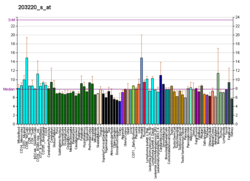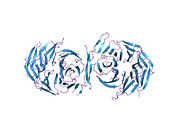Protein-coding gene in the species Homo sapiens
Transducin-like enhancer protein 1 is a protein that in humans is encoded by the TLE1 gene .[ 5] [ 6] [ 7]
Interactions TLE1 has been shown to interact with:
References
^ a b c GRCh38: Ensembl release 89: ENSG00000196781 – Ensembl , May 2017^ a b c GRCm38: Ensembl release 89: ENSMUSG00000008305 – Ensembl , May 2017^ "Human PubMed Reference:" . National Center for Biotechnology Information, U.S. National Library of Medicine .^ "Mouse PubMed Reference:" . National Center for Biotechnology Information, U.S. National Library of Medicine .^ Miyasaka H, Choudhury BK, Hou EW, Li SS (Aug 1993). "Molecular cloning and expression of mouse and human cDNA encoding AES and ESG proteins with strong similarity to Drosophila enhancer of split groucho protein" . European Journal of Biochemistry . 216 (1): 343– 52. doi :10.1111/j.1432-1033.1993.tb18151.x PMID 8365415 . ^ Liu Y, Dehni G, Purcell KJ, Sokolow J, Carcangiu ML, Artavanis-Tsakonas S, Stifani S (Jan 1996). "Epithelial expression and chromosomal location of human TLE genes: implications for notch signaling and neoplasia" . Genomics . 31 (1): 58– 64. doi :10.1006/geno.1996.0009 PMID 8808280 . ^ "Entrez Gene: TLE1 transducin-like enhancer of split 1 (E(sp1) homolog, Drosophila)" .^ Liu F, Liu Y, Li D, Zhu Y, Ouyang W, Xie X, Jin B (Mar 2002). "The transcription co-repressor TLE1 interacted with the intracellular region of gpl30 through its Q domain". Molecular and Cellular Biochemistry . 232 (1– 2): 163– 7. doi :10.1023/A:1014880813692 . PMID 12030375 . S2CID 8270300 . ^ Gao X, Chandra T, Gratton MO, Quélo I, Prud'homme J, Stifani S, St-Arnaud R (Sep 2001). "HES6 acts as a transcriptional repressor in myoblasts and can induce the myogenic differentiation program" . The Journal of Cell Biology . 154 (6): 1161– 71. doi :10.1083/jcb.200104058 . PMC 2150829 PMID 11551980 . ^ a b Levanon D, Goldstein RE, Bernstein Y, Tang H, Goldenberg D, Stifani S, Paroush Z, Groner Y (Sep 1998). "Transcriptional repression by AML1 and LEF-1 is mediated by the TLE/Groucho corepressors" . Proceedings of the National Academy of Sciences of the United States of America . 95 (20): 11590– 5. Bibcode :1998PNAS...9511590L . doi :10.1073/pnas.95.20.11590 PMC 21685 PMID 9751710 . ^ López-Ríos J, Tessmar K, Loosli F, Wittbrodt J, Bovolenta P (Jan 2003). "Six3 and Six6 activity is modulated by members of the groucho family" . Development . 130 (1): 185– 95. doi :10.1242/dev.00185 PMID 12441302 . ^ Grbavec D, Lo R, Liu Y, Stifani S (Dec 1998). "Transducin-like Enhancer of split 2, a mammalian homologue of Drosophila Groucho, acts as a transcriptional repressor, interacts with Hairy/Enhancer of split proteins, and is expressed during neuronal development" . European Journal of Biochemistry . 258 (2): 339– 49. doi :10.1046/j.1432-1327.1998.2580339.x PMID 9874198 . ^ Grbavec D, Lo R, Liu Y, Greenfield A, Stifani S (Jan 1999). "Groucho/transducin-like enhancer of split (TLE) family members interact with the yeast transcriptional co-repressor SSN6 and mammalian SSN6-related proteins: implications for evolutionary conservation of transcription repression mechanisms" . The Biochemical Journal . 337 (1): 13– 7. doi :10.1042/0264-6021:3370013 . PMC 1219929 PMID 9854018 .
Further reading
Eastman Q, Grosschedl R (Apr 1999). "Regulation of LEF-1/TCF transcription factors by Wnt and other signals". Current Opinion in Cell Biology . 11 (2): 233– 40. doi :10.1016/S0955-0674(99)80031-3 . PMID 10209158 . Stifani S, Blaumueller CM, Redhead NJ, Hill RE, Artavanis-Tsakonas S (Oct 1992). "Human homologs of a Drosophila Enhancer of split gene product define a novel family of nuclear proteins". Nature Genetics . 2 (2): 119– 27. doi :10.1038/ng1092-119 . PMID 1303260 . S2CID 32142845 . Grbavec D, Stifani S (Jun 1996). "Molecular interaction between TLE1 and the carboxyl-terminal domain of HES-1 containing the WRPW motif". Biochemical and Biophysical Research Communications . 223 (3): 701– 5. doi :10.1006/bbrc.1996.0959 . PMID 8687460 . Husain J, Lo R, Grbavec D, Stifani S (Jul 1996). "Affinity for the nuclear compartment and expression during cell differentiation implicate phosphorylated Groucho/TLE1 forms of higher molecular mass in nuclear functions" . The Biochemical Journal . 317 (Pt 2): 523– 31. doi :10.1042/bj3170523 . PMC 1217518 PMID 8713081 . Palaparti A, Baratz A, Stifani S (Oct 1997). "The Groucho/transducin-like enhancer of split transcriptional repressors interact with the genetically defined amino-terminal silencing domain of histone H3" . The Journal of Biological Chemistry . 272 (42): 26604– 10. doi :10.1074/jbc.272.42.26604 PMID 9334241 . Levanon D, Goldstein RE, Bernstein Y, Tang H, Goldenberg D, Stifani S, Paroush Z, Groner Y (Sep 1998). "Transcriptional repression by AML1 and LEF-1 is mediated by the TLE/Groucho corepressors" . Proceedings of the National Academy of Sciences of the United States of America . 95 (20): 11590– 5. Bibcode :1998PNAS...9511590L . doi :10.1073/pnas.95.20.11590 PMC 21685 PMID 9751710 . Grbavec D, Lo R, Liu Y, Greenfield A, Stifani S (Jan 1999). "Groucho/transducin-like enhancer of split (TLE) family members interact with the yeast transcriptional co-repressor SSN6 and mammalian SSN6-related proteins: implications for evolutionary conservation of transcription repression mechanisms" . The Biochemical Journal . 337 (Pt 1): 13– 7. doi :10.1042/0264-6021:3370013 . PMC 1219929 PMID 9854018 . Grbavec D, Lo R, Liu Y, Stifani S (Dec 1998). "Transducin-like Enhancer of split 2, a mammalian homologue of Drosophila Groucho, acts as a transcriptional repressor, interacts with Hairy/Enhancer of split proteins, and is expressed during neuronal development" . European Journal of Biochemistry . 258 (2): 339– 49. doi :10.1046/j.1432-1327.1998.2580339.x PMID 9874198 . Ren B, Chee KJ, Kim TH, Maniatis T (Jan 1999). "PRDI-BF1/Blimp-1 repression is mediated by corepressors of the Groucho family of proteins" . Genes & Development . 13 (1): 125– 37. doi :10.1101/gad.13.1.125 . PMC 316372 PMID 9887105 . Tetsuka T, Uranishi H, Imai H, Ono T, Sonta S, Takahashi N, Asamitsu K, Okamoto T (Feb 2000). "Inhibition of nuclear factor-kappaB-mediated transcription by association with the amino-terminal enhancer of split, a Groucho-related protein lacking WD40 repeats" . The Journal of Biological Chemistry . 275 (6): 4383– 90. doi :10.1074/jbc.275.6.4383 PMID 10660609 . Wang JC, Waltner-Law M, Yamada K, Osawa H, Stifani S, Granner DK (Jun 2000). "Transducin-like enhancer of split proteins, the human homologs of Drosophila groucho, interact with hepatic nuclear factor 3beta" . The Journal of Biological Chemistry . 275 (24): 18418– 23. doi :10.1074/jbc.M910211199 PMID 10748198 . Yao J, Lai E, Stifani S (Mar 2001). "The winged-helix protein brain factor 1 interacts with groucho and hes proteins to repress transcription" . Molecular and Cellular Biology . 21 (6): 1962– 72. doi :10.1128/MCB.21.6.1962-1972.2001 . PMC 86788 PMID 11238932 . Gao X, Chandra T, Gratton MO, Quélo I, Prud'homme J, Stifani S, St-Arnaud R (Sep 2001). "HES6 acts as a transcriptional repressor in myoblasts and can induce the myogenic differentiation program" . The Journal of Cell Biology . 154 (6): 1161– 71. doi :10.1083/jcb.200104058 . PMC 2150829 PMID 11551980 . Dasen JS, Martinez Barbera JP, Herman TS, Connell SO, Olson L, Ju B, Tollkuhn J, Baek SH, Rose DW, Rosenfeld MG (Dec 2001). "Temporal regulation of a paired-like homeodomain repressor/TLE corepressor complex and a related activator is required for pituitary organogenesis" . Genes & Development . 15 (23): 3193– 207. doi :10.1101/gad.932601 . PMC 312840 PMID 11731482 . Dintilhac A, Bernués J (Mar 2002). "HMGB1 interacts with many apparently unrelated proteins by recognizing short amino acid sequences" . The Journal of Biological Chemistry . 277 (9): 7021– 8. doi :10.1074/jbc.M108417200 hdl :10261/112516 PMID 11748221 . Liu F, Liu Y, Li D, Zhu Y, Ouyang W, Xie X, Jin B (Mar 2002). "The transcription co-repressor TLE1 interacted with the intracellular region of gpl30 through its Q domain". Molecular and Cellular Biochemistry . 232 (1– 2): 163– 7. doi :10.1023/A:1014880813692 . PMID 12030375 . S2CID 8270300 . Pickles LM, Roe SM, Hemingway EJ, Stifani S, Pearl LH (Jun 2002). "Crystal structure of the C-terminal WD40 repeat domain of the human Groucho/TLE1 transcriptional corepressor" . Structure . 10 (6): 751– 61. doi :10.1016/S0969-2126(02)00768-2 PMID 12057191 .
PDB gallery
1gxr : WD40 REGION OF HUMAN GROUCHO/TLE1
2ce8 : AN EH1 PEPTIDE BOUND TO THE GROUCHO-TLE WD40 DOMAIN.
2ce9 : A WRPW PEPTIDE BOUND TO THE GROUCHO-TLE WD40 DOMAIN.











